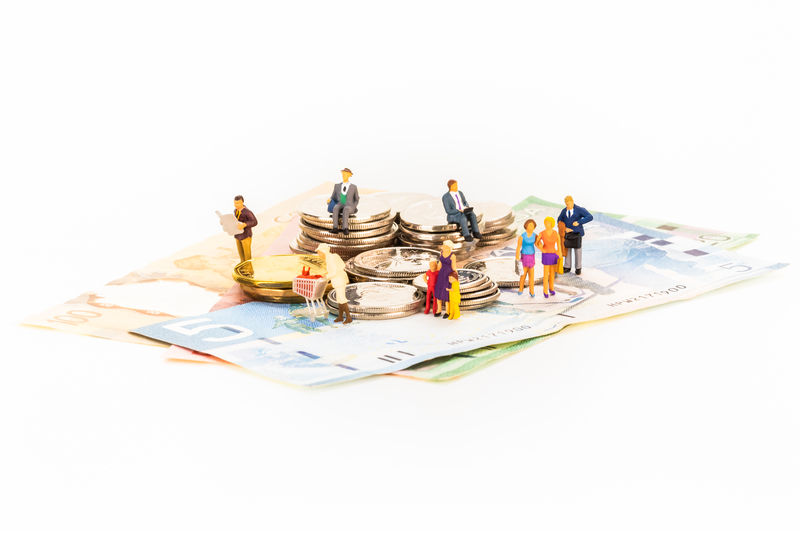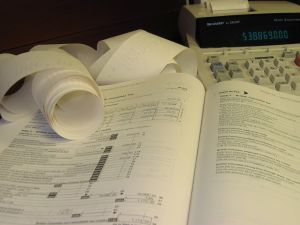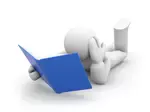- Essential Bookkeeping Habits For Audit Ready Books in Canada
- Canadian Income Tax Compliance
- Year-End and Tax Preparation
Year-end and Tax Preparation
A Simple Tax Compliance Method For The Self-Employed
By L.Kenway BComm CPB Retired
This is the year you get all your ducks in a row! Start by starting.
Edited October 23, 2025 | Updated February 24, 2025 | Revised July 18, 2024 | Originally Published on Bookkeeping-Essentials.com in February 2009
WHAT'S IN THIS ARTICLE
How To Get Started | 3 options: 1. No-Tech Option 2. Low-Tech Option 3. Affordable Tech Option | Thinking Ahead | Simple Cash Management System | Wrap-up
MORE >> Learn The 6 Components To Setting Up Your Bookkeeping System

If you keep your books solely for year-end and tax preparation purposes, tax experts suggest you establish this simple method to meet this requirement.
Steps To Filing Your Self-Employment Tax Return
It can be especially stressful when year-end and tax preparation comes around. Even more so if you developed the bad habit of ignoring your bookkeeping throughout the year. Here are the steps to remove some of the stress from tax time:
- Start organizing early in January to relieve your stress and your tax preparer's stress. It may cost less if you submit your information earlier in the tax season, say March 1st, rather than later (any time in April).
Before you begin, set up a CRA MyAccount if you haven't already. Many tax slips (T4A, T5s, etc.) are available electronically through this portal, making tax preparation easier.
Once that is done, if you haven't been organizing your tax receipts throughout the year, start by gathering all the information that isn't available on CRA's website. This includes your business receipts for expenses, medical receipts, charitable donations, and other documentation that supports your deductions.
More >> 2024 Tax Alert - Interest rates on unpaid balances
- Organize your tax information using the simple year-end and tax preparation method outlined below.
TAX ALERT: A good tax preparer will ask to see your records and receipts. While self-employed individuals have until June 16, 2025, to file their 2024 tax return, remember that any taxes owing are still due by April 30. Interest starts accumulating after April 30, regardless of the June filing deadline. - Take your organized information to your tax preparer. Another option only if you are relatively knowledgable about all aspects of your business's finances and CRA compliance rules is to do your taxes yourself using one of the online tax platforms.
TAX ALERT: Go to your tax preparation interview ready to answer questions. - Make sure you understand how much the tax preparation service is going to cost prior to allowing the tax preparer to prepare your return. For clarity, get a quote prior to proceeding so you don't have sticker shock at the end.
TAX ALERT: I would stay away from any tax preparer that charges a fee based on the size of your refund.
- Understand that it is still your responsibility for what the tax return says even if a professional prepared it. That's why it is important to have the tax preparer review the finished return with you. Don't let them skip this step! Don't sign off until this has been done.
TAX ALERT: Never sign a blank or incomplete return.
More >> What It Means When You Sign Your Income Tax Return
- If you receive a notice from CRA requiring action, make sure you let your tax preparer know. They will address CRA's concerns often at no charge as it may be included as part of the tax preparation service.
TAX ALERT: Choose a tax preparer that is available all year and not just at tax time.
Three Year-End and Tax Preparation Options
Following are three year-end and tax preparation options; (1) old school no tech; (2) low tech, and (3) affordable tech. Choose the one you are most comfortable with.
 Old School No Tech Solution for Self-Employed Tax Preparation
Old School No Tech Solution for Self-Employed Tax PreparationOld School No Tech Solution
Simple Year-End and Tax Preparation Method
What this method requires:
- Before you start, you will need a copy of your T2125 Schedule included in your prior year's T1 tax return for reference.
- A supply of file folders or 9 x 12 envelopes
- At year-end, access to an old-fashioned printing calculator with a paper tape.
Step One: At the beginning of each calendar year, refer to your prior year T2125 Schedule. Take a file folder (or envelope) and write on the front - the year, the tax line number from the T2125 Schedule, and the expense name. Do this for every line you used on last year's T2125 Schedule or expect to submit a tax claim on this year.
Step Two: Throughout the year, place all your corresponding business receipts in the appropriate file folder. It's so much easier to do this throughout the year rather than sitting down to sort a pile of receipts at tax time. Creating this habit makes receipt organization so much less of a chore. You are also less likely to lose tax deductions due to lost receipts.
Step Three: At the end of the year, run a tape listing of every receipt for each file folder. Write the total expense for that line on the outside of the file folder. Insert or staple the paper tape listing to the inside of the file folder.
Low-Tech Option
1. You could go low-tech and create these folders on your computer for the receipts. Instead of filing paper receipts, you will take pictures of all your receipts and store them in the electronic folders you created. Give each receipt a good name for retrieval purposes such as Line xxxx YYYY-MM-DD Supplier Name Amount. It ensures your year-end and tax preparation will be a breeze!
2. Use an Excel spreadsheet instead of a tape listing calculator to tally each line.
Step Four: Keep all file folders pertaining to one tax year together in a box. If you are audited, you've got everything you need to support your return.
Why It Works: It is a simple, low-tech way to keep and get your tax information ready for your tax preparer.
Drawback: It makes it onerous for your tax preparer to determine if all your deductions listed are allowable. You really need to be on top of knowing the rules.
It's also not the best way to implement good bookkeeping practices in your business. It does not provide information on whether you are making money or not. You could work around this if you are willing to use several bank accounts to manage your cash flow (see below).
Other Filing Options: Consider other low tech filing organization options if you want to use your records to help you run your business.
Affordable Tech Option
If you want to have access to your historical information in the future to assist with strategic planning, you could use a program such as QuickBooks Online (QBO) Canada - Self-Employed version like a calculator:
- Using QBO's Online Bank Feeds is a helpful and time-saving feature that reduces your data entry time;
- As is the app that captures receipts on the fly; and
- You can create and send professional invoices from your phone.
What this method requires:
- An online subscription to QuickBooks Online (QBO) Canada - Self-Employed version
- Willingness to connect the software to your bank
- A smartphone to download the receipt capture app that is included in the subscription.
At Year-End and Tax Preparation Time:
Instead of running a tape listing, you would print out a QBO report (in PDF format if you want to be paperless) for each expense line and place it in the file folder.
If You Don't Want To Use Bank Feeds: Just set up a bank account called Cash and be sure to enter all your sales through Sales Receipt form and pay all bills through the Cash account using Write Cheques form. You won't have a set of books prepared in accordance with Canadian ASPE (Accounting Standards for Private Enterprise), but you should have all the information you need for your tax preparer to file your tax return.
Best Feature: Organizes your receipts in the cloud to manage your tax deductions so you are audit-ready. It makes year-end and tax preparation relatively painless.
What's Great About This Option: You could have reconciled bank and credit card statements. This shows your tax preparer you have captured your income and expenses.
Who It's Not For: This version of QBO is not for businesses that have employees or need to track QST. You would need to upgrade the QBO plan to one that offers the additional features you require.
MORE >> Be Audit Ready If CRA Examines Transactions Between Family Members
Thinking ahead to make year-end and tax preparation easier
Here are some tips to reach your goal of getting all your ducks in a row:
- Take an introductory bookkeeping course at your community college or online to learn the basics. You'll come away more confident you'll be on top of your business finances.
- If you haven't already, open a separate bank account for your business. Don't mix your business finances with your personal finances.
More >> Why you want a CRA audit trail? - Schedule your bookkeeping tasks so they don't pile up. Think of it as "cleaning as you go". It's much easier to clean the fridge if you wipe any spills as they occur rather than weeks later when they harden. Bookkeeping is the same. Keeping on top of it makes it less of a chore. Daily is best but weekly works too.
- Nowadays, technology is available and affordable for small businesses. Digitize all your bills, receipts, and of course invoices. Switch to digital receipts where possible. It is easier to keep them organized and gets rid of the problem of faded, lost, or damaged receipts.
More >> Can you shred your scanned receipts? - Take advantage of one of the many small business accounting software out there such as QuickBooks Online, Xero, or Sage. It really does make everything easier and reduces bookkeeping errors because it's programmed to know the rules. You will need to take some initial training to ensure you are using the various modules correctly and not making a mess of things.
- Once your data is entered into your accounting program, review the financial statements for issues you can get resolved before they become a problem.
More >> How to mine your business reports to run your business better - If you are not a do-it-yourselfer, hire a certified professional bookkeeper to handle this task for you. It's important to not get behind on government reporting and have information you can use to run your business instead of running it from the seat of your pants.

Year-End And Tax Preparation
Self Employed Profit First* Cash Management System
Self-employed business owners who only do their bookkeeping sporadically or for year-end and tax preparation need a method to manage their cash flow. Cash is what keeps your business going. This system helps with that. It gives you a clear picture of your cash position at the start of each day allowing you to get a feel for your cash flow trends and whether you need to change your plans.
MORE >> Learn more about this simple cash management system.
MORE >> Learn how to pay yourself on a regular basis.
Year-end and Tax Preparation
Wrap-Up
- If you keep your books solely for year-end and tax preparation purposes, tax experts suggest you establish the simple method outlined above to meet this requirement.
- I laid out three options to implement this system: no tech, low tech, and affordable tech.
- The Profit First cash management system works well for self-employed business owners who don't do their books during the year. It puts you in control of your cash flow instead of flying by the seat of your pants.
* Profit First is a registered trademark in the U.S. and other countries.
Disclaimer: I am not a certified Profit First Professional or associated with Mike Michalowich. I just like the system and introduced some of my client's to it. Get Mike's book to learn more about the system.












